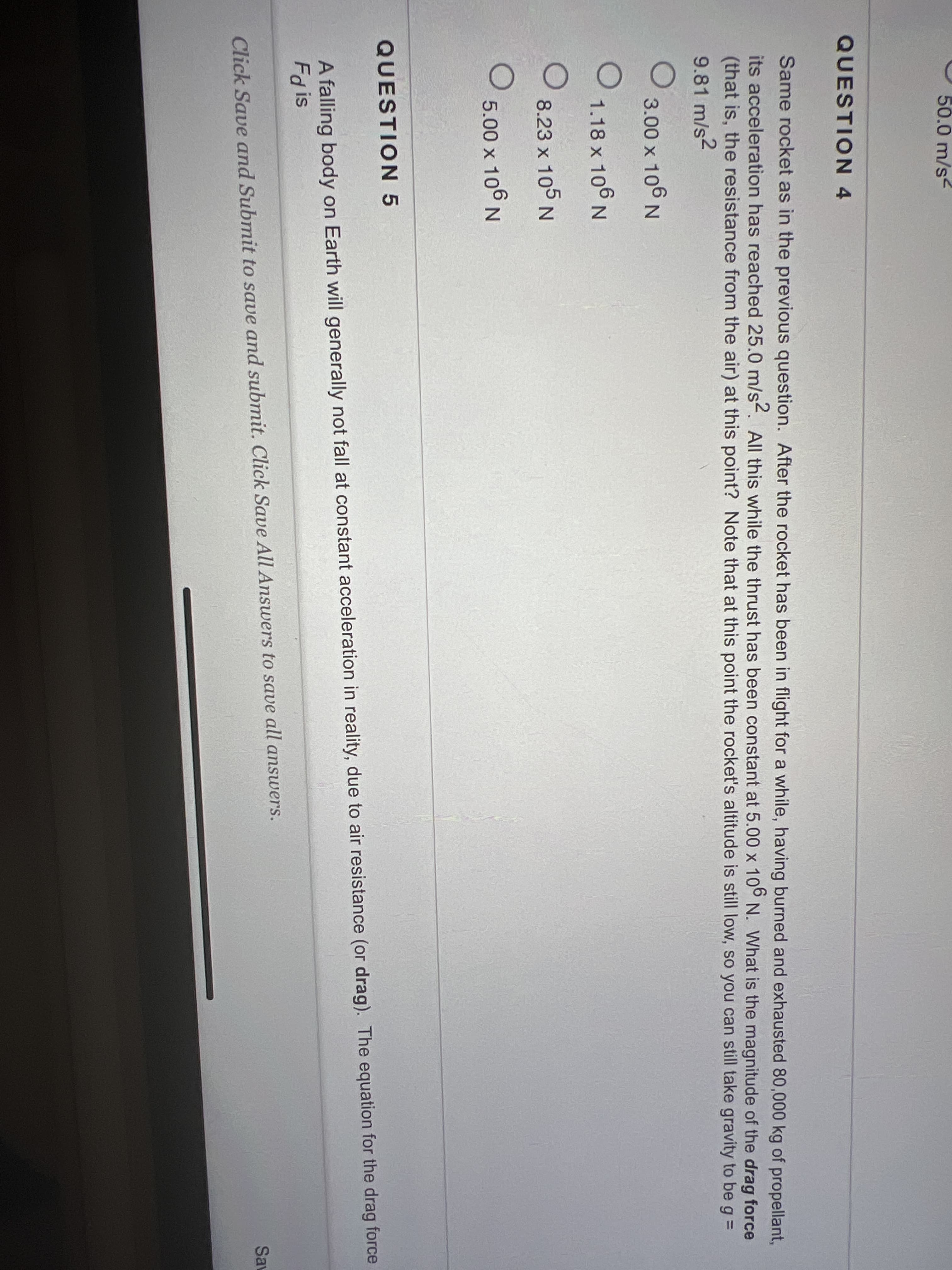50.0 m/s- QUESTION 4 Same rocket as in the previous question. After the rocket has been in flight for a while, having burned and exhausted 80,000 kg of propellant, its acceleration has reached 25.0 m/s-. All this while the thrust has been constant at 5.00 x 10° N. What is the magnitude of the drag force (that is, the resistance from the air) at this point? Note that at this point the rocket's altitude is still low, so you can still take gravity to be g = 9.81 m/s2 3.00 x 106 N 1.18 x 106 N 8.23 x 105 N 5.00 x 106 N QUESTION 5 A falling body on Earth will generally not fall at constant acceleration in reality, due to air resistance (or drag). The equation for the drag force Fd is Click Save and Submit to save and submit. Click Save All Answers to save all answers. Sav
50.0 m/s- QUESTION 4 Same rocket as in the previous question. After the rocket has been in flight for a while, having burned and exhausted 80,000 kg of propellant, its acceleration has reached 25.0 m/s-. All this while the thrust has been constant at 5.00 x 10° N. What is the magnitude of the drag force (that is, the resistance from the air) at this point? Note that at this point the rocket's altitude is still low, so you can still take gravity to be g = 9.81 m/s2 3.00 x 106 N 1.18 x 106 N 8.23 x 105 N 5.00 x 106 N QUESTION 5 A falling body on Earth will generally not fall at constant acceleration in reality, due to air resistance (or drag). The equation for the drag force Fd is Click Save and Submit to save and submit. Click Save All Answers to save all answers. Sav
University Physics Volume 1
18th Edition
ISBN:9781938168277
Author:William Moebs, Samuel J. Ling, Jeff Sanny
Publisher:William Moebs, Samuel J. Ling, Jeff Sanny
Chapter5: Newton's Law Of Motion
Section: Chapter Questions
Problem 57P: Two teams of nine members each engage in tug-of-war. Each of the first team’s members has an average...
Related questions
Question

Transcribed Image Text:50.0 m/s-
QUESTION 4
Same rocket as in the previous question. After the rocket has been in flight for a while, having burned and exhausted 80,000 kg of propellant,
its acceleration has reached 25.0 m/s-. All this while the thrust has been constant at 5.00 x 10° N. What is the magnitude of the drag force
(that is, the resistance from the air) at this point? Note that at this point the rocket's altitude is still low, so you can still take gravity to be g =
9.81 m/s2
3.00 x 106 N
1.18 x 106 N
8.23 x 105 N
5.00 x 106 N
QUESTION 5
A falling body on Earth will generally not fall at constant acceleration in reality, due to air resistance (or drag). The equation for the drag force
Fd is
Click Save and Submit to save and submit. Click Save All Answers to save all answers.
Sav
Expert Solution
This question has been solved!
Explore an expertly crafted, step-by-step solution for a thorough understanding of key concepts.
This is a popular solution!
Trending now
This is a popular solution!
Step by step
Solved in 3 steps with 3 images

Knowledge Booster
Learn more about
Need a deep-dive on the concept behind this application? Look no further. Learn more about this topic, physics and related others by exploring similar questions and additional content below.Recommended textbooks for you

University Physics Volume 1
Physics
ISBN:
9781938168277
Author:
William Moebs, Samuel J. Ling, Jeff Sanny
Publisher:
OpenStax - Rice University

Principles of Physics: A Calculus-Based Text
Physics
ISBN:
9781133104261
Author:
Raymond A. Serway, John W. Jewett
Publisher:
Cengage Learning

Physics for Scientists and Engineers, Technology …
Physics
ISBN:
9781305116399
Author:
Raymond A. Serway, John W. Jewett
Publisher:
Cengage Learning

University Physics Volume 1
Physics
ISBN:
9781938168277
Author:
William Moebs, Samuel J. Ling, Jeff Sanny
Publisher:
OpenStax - Rice University

Principles of Physics: A Calculus-Based Text
Physics
ISBN:
9781133104261
Author:
Raymond A. Serway, John W. Jewett
Publisher:
Cengage Learning

Physics for Scientists and Engineers, Technology …
Physics
ISBN:
9781305116399
Author:
Raymond A. Serway, John W. Jewett
Publisher:
Cengage Learning

College Physics
Physics
ISBN:
9781938168000
Author:
Paul Peter Urone, Roger Hinrichs
Publisher:
OpenStax College